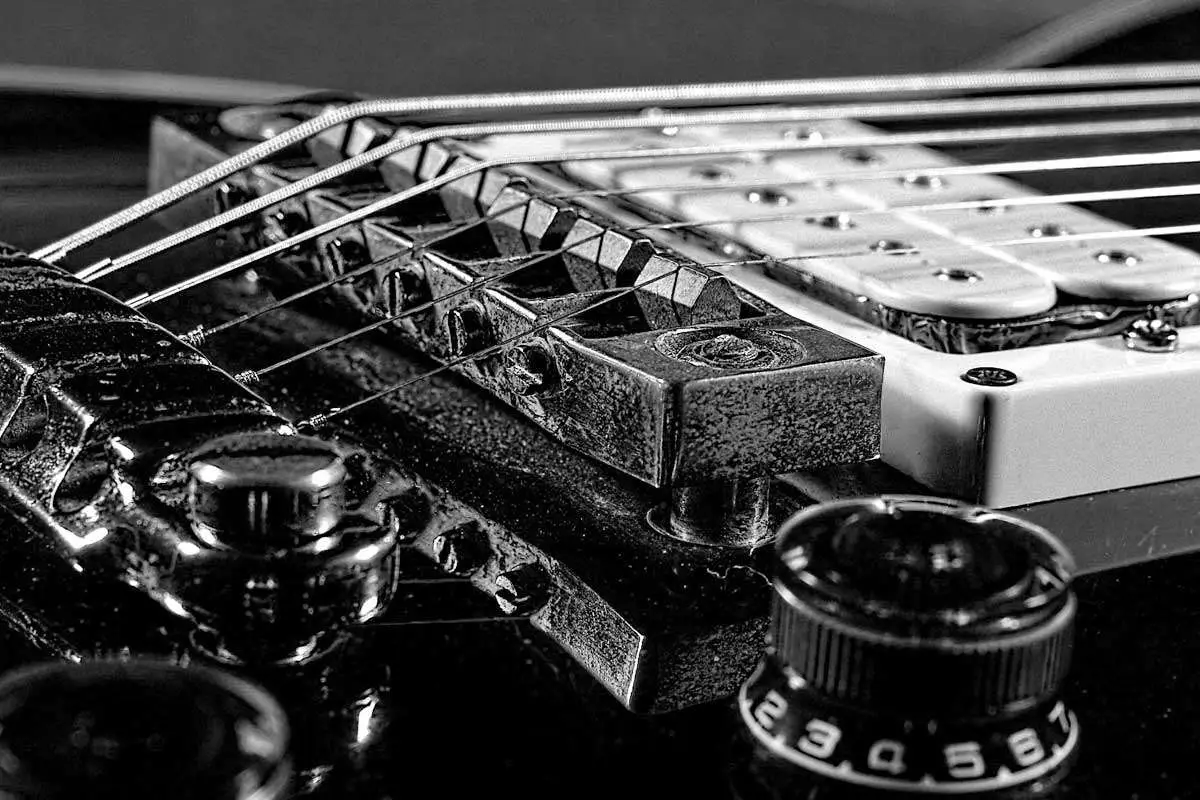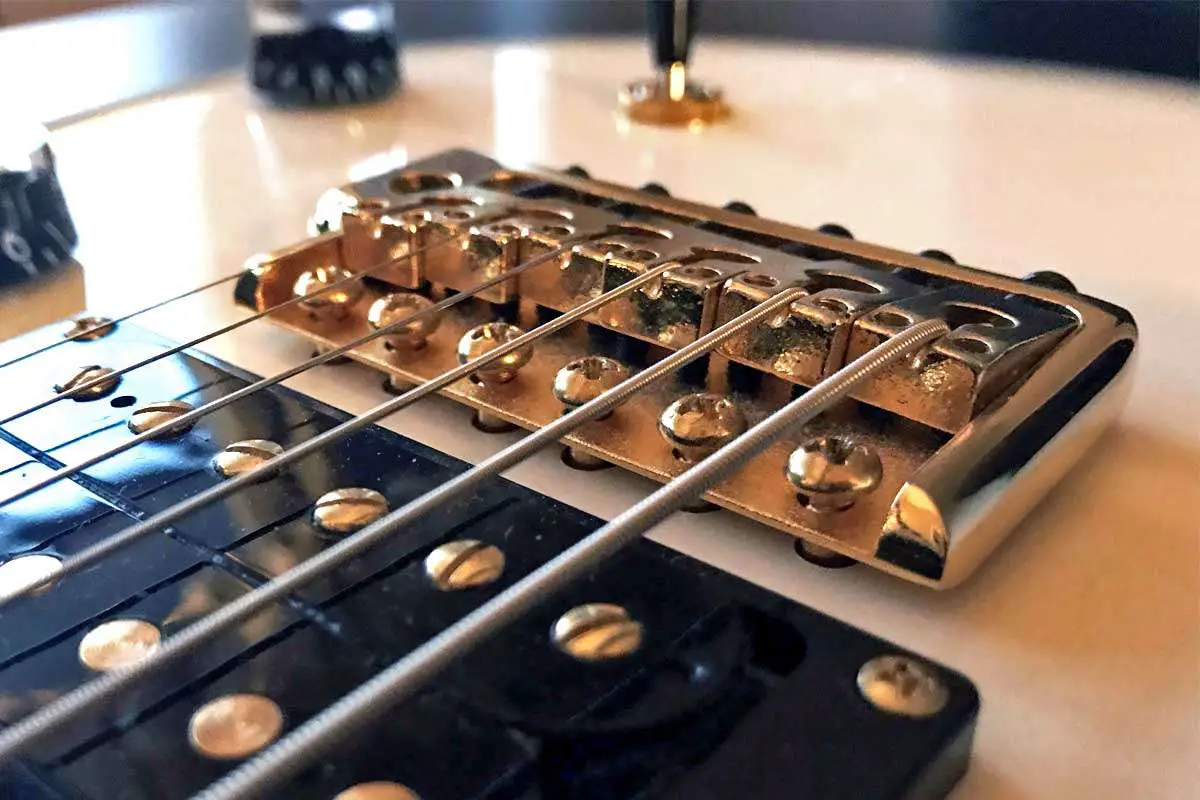Unlock the full potential of your guitar with Drop G tuning, a powerful variation that has captivated musicians eager to explore new sonic landscapes. By lowering the sixth string from E to G, this tuning delivers a rich, resonant timbre that enhances your sound.
Perfect for genres like metal, progressive rock, and hard rock, Drop G tuning produces thunderous low-end tones and dynamic chugging riffs that will elevate your playing. Its ability to create engaging harmonic possibilities makes it a favorite among guitarists and audiences alike.
In this guide, we’ll not only delve into the benefits of Drop G tuning but also show you how to tune both 6-string & 7-string guitars to achieve this exciting sound. Get ready to reach new thundering lows!

Understanding Guitar Tuning
Standard Tuning
Standard tuning is the most common tuning for guitars and serves as the foundation for most beginners. In this setup, the strings are tuned from lowest to highest as E, A, D, G, B, and E. This tuning allows you to play a wide variety of songs and is essential for learning basic chords and scales.
As you become comfortable with standard tuning, you might want to explore alternate tunings. These involve adjusting the pitch of one or more strings, opening up new sonic possibilities. Alternate tunings can range from open tunings, which create rich, resonant chords with minimal finger movement, to more specialized tunings that cater to specific musical genres.
By experimenting with these tunings, you can craft unique sounds, discover fresh chord voicings, and inspire your creativity.
Drop Tuning
Drop tuning is a popular subset of alternate tunings where at least one string is tuned lower than its standard pitch. This technique is particularly favored in genres like metal and hard rock, as it produces a heavier, deeper sound that enhances low-end power and allows for powerful, resonating riffs.
One of the key benefits of drop tunings is their ability to simplify complex chord shapes. For beginners, this means you can play one-finger power chords, making it easier to focus on rhythm and dynamics without getting bogged down by intricate fingerings. Among the various drop tunings, Drop D and Drop C are popular for their balance of accessibility and depth.
More extreme options like Drop B and Drop G tuning offer even richer tonal dimensions, inviting you to explore a distinct sonic signature.
The Theory Behind Drop G Tuning

Drop G tuning involves lowering the pitch of the top strings and lowering the bottom string even further.
This modification enhances the lower frequency range of the guitar, making it particularly suitable for heavy and aggressive styles of music, such as metal and hard rock.
Mind you this down tuning is extreme, and so baritone guitars are better suited for it because of their longer scale lengths . Still, your can accomplish playing with this tuning on a standard 25.5″ scale guitar but it will require some heavy modifications.
Drop G Tuning For 6 String Guitar
In Drop G tuning, the lowest-pitched string is lowered by 4.5 steps (9 semitones) to G & the other strings are lowered by 3.5 steps (7 semitones).
The resulting open string notes in Drop G tuning are G D G C E A.
Drop G Tuning For 7 String Guitar
The standard tuning is B E A D G B E.
In Drop G tuning, the lowest-pitched string is lowered by 2 steps (4 semi tones) & the rest of the strings are lowered by 1 full step (2 semi tones).
The resulting open string notes in Drop G tuning for a 7 string guitar are G D G C F A D.
Drop G tuning involves creating a rich and powerful low end by maintaining the familiar chord shapes and scale patterns found in standard tuning while achieving a lower fundamental pitch.
This allows for heavy, distorted power chords and chugging riffs on the lower strings, which are often characteristic of genres like metal.
Overall, Drop G tuning offers a distinctive tonal palette that suits the sonic demands of modern heavy music.
How To Tune a 6 String To Drop G (GDGCEA)
When attempting this tuning, be sure to start the de-tuning process from the thinnest string first.
Why? Loosening the thicker strings first will add more tension than the higher strings can handle & cause a breakage.
Begin by tuning your high E string down 3.5 steps ( 7 half steps) from E to A.
Next detune the B string down to E, which is also 3.5 steps.
Then, tune the remaining three strings (except the lowest string) down 3.5 steps.
Finally drop the low E string down to G which will be 4.5 steps (9 half steps).
Reference Pitches:
How To Tune a 7 String to Drop G (GDGCFAD)
Tuning a seven string is slightly different than a six string guitar because the downtuning doesn’t loosen the strings as much, but caution should still be taken.
You could start with the thickest string or if you want to play it safe and not accidentally snap your thinnest string, then start with that one instead.
For a seven string guitar, you will lower all the strings by 1 full step (2 half steps).
The low B string will be tuned 2 full steps down (4 half steps).
Reference Pitches:
Considerations For Using This Tuning
Baritone guitars are better suited for this tuning (because of their longer scale length) than a regular 25.5″ scale six string guitar, as you will loose considerable string tension if using light gauge strings.
If using a standard guitar though, we recommend the lowest string of the set to be about gauge 66 to 70. An example would be the GHS “Heavyweight Low Tuned” strings (11-070). See
Also with the strings being so large, you will need to take into account the size of the guitar nut slots, saddles, and tuning pegs to make sure they can support the new strings.
Intonation, as well as truss rod & action adjustments will also have to be made in order to have optimal playability & tone. If not familiar with these undertakings yourself, it’s best to take the guitar to a technician or consider looking at some baritone guitars which are better suited for this tuning.
Tips For Staying In Tune
Regardless of the guitar tuning you choose, here’s a few quick tips to keep your guitar playing & sounding its best.
Stretch Strings: Stretch new strings after installation to help them settle and stabilize.
Proper String Winding: Wind strings neatly around tuning pegs to minimize slippage.
Lubricate Nut & Bridge: Apply graphite or specialized lubricant to nut slots and bridge saddles to reduce friction.
Stable Environment: Keep your guitar in a consistent environment with stable humidity and temperature.
Tuning Up: Tune up to pitch, not down, as this helps maintain proper tension and stability.
Stretch During Play: Stretch strings occasionally while playing to minimize tuning shifts.
Gentle Tuning: Tune in small, gradual adjustments to reduce stress on strings and neck.
Avoid Extreme Changes: Minimize rapid shifts between extreme tunings to avoid excessive stress.
Regular Maintenance: Keep your guitar well-maintained with proper setup and string changes.

Heavy Metal Bands That Use Drop G Tuning
Drop G tuning has become a favorite among many heavy metal bands, allowing them to create the powerful, resonant sounds that define the genre. Here are some notable bands that have embraced this tuning, along with a bit of background on their contributions to the heavy music scene:
- Alphawolf: Known for their aggressive sound and emotionally charged lyrics, Alphawolf blends metalcore and hardcore elements, often using Drop G tuning to achieve their signature heavy riffs. Their song “Akudama” showcases the tuning’s ability to deliver thunderous low-end tones.
- Born of Osiris: This band is a pioneer of the progressive metalcore genre, incorporating complex rhythms and intricate melodies. With tracks like “Ascension,” they utilize Drop G tuning to enhance their dynamic sound, making their music both heavy and melodic.
- Chelsea Grin: Renowned for their deathcore roots, Chelsea Grin employs Drop G tuning to create crushing breakdowns and intense sonic atmospheres. Their music often explores dark themes, and the tuning helps amplify the heaviness of tracks like “Lilith.”
- Fit for an Autopsy: This band delivers a blend of deathcore and metal, using Drop G tuning to craft powerful riffs and haunting melodies. Their relentless sound is exemplified in songs like “Mirrors,” where the tuning adds depth and aggression.
- Hollow Front: Emerging from the modern metalcore scene, Hollow Front uses Drop G tuning to create emotionally resonant music that combines heavy instrumentation with heartfelt lyrics. Their ability to balance melody and aggression makes them stand out in the genre.
- InVisions: This band combines elements of metalcore and post-hardcore, and they often utilize Drop G tuning to achieve a heavier sound. Their energetic performances and impactful lyrics resonate well with fans looking for both intensity and depth.
- Knocked Loose: Known for their raw energy and hardcore influences, Knocked Loose employs Drop G tuning to create a powerful sound that drives their music. Tracks like “Mistakes Like Fractures” highlight their ability to blend melody with heavy riffs.
- Time, the Valuator: This band merges progressive elements with heavy music, utilizing Drop G tuning to enhance their complex compositions. Their unique sound is characterized by intricate guitar work and dynamic shifts, making them a notable presence in the scene.
- Wage War: With their blend of metalcore and hard rock, Wage War has gained significant attention for their catchy hooks and heavy breakdowns. The use of Drop G tuning in songs like “Stitch” allows them to create a rich, powerful sound that resonates with fans.
- Within the Ruins: This band is known for their technical prowess and relentless energy, often using Drop G tuning to achieve their signature heavy sound. Their music showcases a blend of melodic elements and intense breakdowns, making them a standout in the modern metal scene.
Other Alternative Tunings
Frequently Asked Questions
What songs are in Drop G tuning?
Several songs that feature Drop G tuning include “Akudama” by Alphawolf, “Endurance” by Any Given Day, and “Ascension” by Born of Osiris. This tuning is popular in heavy music genres, making it a great choice for creating powerful riffs & deep tones. Exploring these songs can help you understand how to incorporate Drop G into your own playing.
What is the most common drop tuning?
The most common drop tuning for guitar is Drop D tuning. Its simplicity makes it easy for beginners to implement, allowing for quick transitions from standard E tuning. Many guitarists use Drop D as a stepping stone to explore more complex tunings like Drop G.
How does Drop G tuning affect my guitar’s string tension?
Drop G tuning significantly lowers the tension on the strings, especially the lowest string, which can affect playability and feel. This change can make the strings feel looser, which may require adjustments to your guitar’s setup for optimal performance. If you’re using a standard guitar, consider using heavier gauge strings to maintain proper tension.
Can I play the same chords in Drop G tuning as in standard tuning?
Yes, you can play many of the same chord shapes in Drop G tuning as you would in standard tuning, but they will sound different due to the lower pitch. Some chord shapes may need slight adjustments to accommodate the tuning, but the familiarity of standard shapes can make the transition easier. Experimenting with these shapes will help you discover new sounds and voicings.
Is Drop G tuning suitable for beginners?
While Drop G tuning can be a bit challenging for absolute beginners, it is still accessible for those who have a grasp of basic chords and techniques. It simplifies certain power chords, making it easier to play heavier music styles. As you grow more comfortable with your playing, exploring Drop G can enhance your skills and creativity.
Do I need special equipment to use Drop G tuning?
You don’t necessarily need special equipment to use Drop G tuning, but a guitar with a longer scale length, like a baritone guitar, can handle the lower tension better. If you’re using a standard guitar, consider using heavier gauge strings to maintain sound quality and stability. Additionally, a proper setup may be required to ensure optimal playability and intonati
